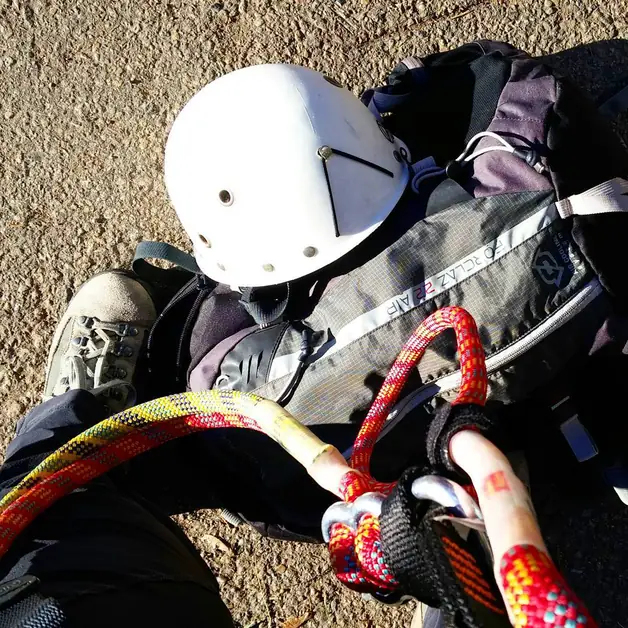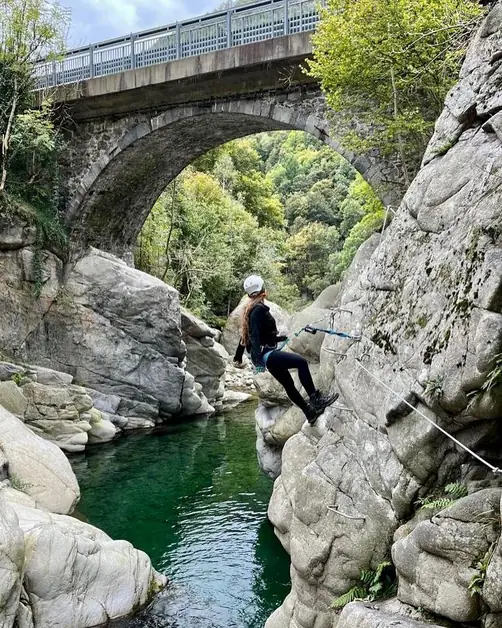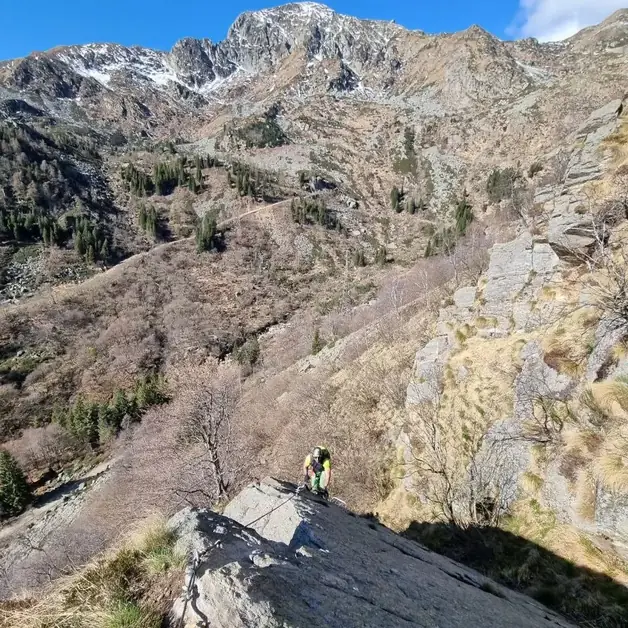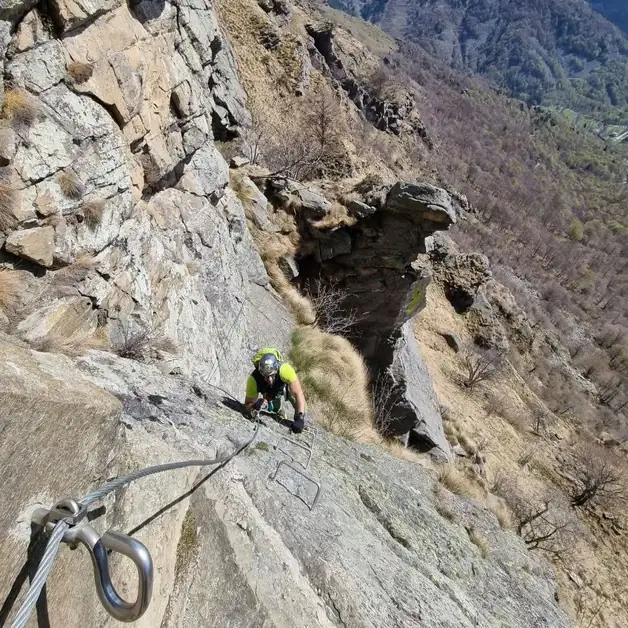Ferrata del Limbo an adventure between landscapes and history
The Ferrata del Limbo offers a unique experience among breathtaking views and history.

Where is the Ferrata del Limbo and why is it so fascinating?
The Ferrata del Limbo develops along the east walls of Monte Mucrone, above Oropa, in the province of Biella, in the heart of the Piedmont Prealps. It is one of the most famous ferratas in Biella, inaugurated in 2001 at the proposal of Alpine Guide Gianni Lanza, and is considered the first via ferrata in Biella and one of the first in Piedmont. It is quite a challenging ferrata, requiring good training and familiarity with alpine paths. The environment is isolated and wild, with a spectacular view of Monte Rosa, Cervino, and the entire Oropa basin.
Where does the Ferrata del Limbo start?
The starting point is the upper station of the Oropa-Lago Mucrone cable car. To get there, you start from Biella and take the SP144 up to Oropa, where you park in the large square near the Sanctuary. From here, the cable car quickly takes you to Lago del Mucrone, at an altitude of 1900 meters. This point represents the beginning of numerous hiking and climbing itineraries, including the Ferrata del Limbo.
What is the approach to the Ferrata del Limbo like?
The approach is long and not always well marked, but very scenic. From the upper station, you follow the signs for "Ferrata del Limbo (high path)", which lead towards Lago del Mucrone. You walk along the left side of the lake, following the indication for Colle del Limbo and Mucrone East Wall. The path continues at a mid-slope between rocks and gravel, with fixed ropes in the steepest sections. You then reach a gully, marked by some stone cairns, which you ascend until you identify on the right the metal steps marking the start of the ferrata. Average time: 1h 15’ from the upper station of the cable car, or 45 minutes from the lake.
How difficult is the Ferrata del Limbo?
The ferrata is of medium difficulty, but challenging due to its length and elevation gain. It does not present technically extreme passages thanks to the abundance of steps and steel cables, but the exposure and wild environment make it suitable for those with prior experience in via ferratas. Complete equipment is necessary: helmet, harness with via ferrata kit and absorber, gloves, and hiking boots with good grip.
How does the Ferrata del Limbo develop?
The route is divided into three main sections, all exciting and varied. 1. First section (Colle del Limbo) You start on a vertical dihedral, staying on the right side. The first few meters are slightly overhanging but well equipped. After the dihedral, you turn left along a diagonal ledge and tackle a vertical wall that ends on a panoramic terrace, the Colle del Limbo. This first part is physical and very exposed, but offers breathtaking views of the Oropa basin. Duration: about 120 meters of vertical development. 2. Second section (Chimney and central slab) From here, you tackle a vertical chimney between the rocks, made easier by the steps indicating the most comfortable movements. At the top of the chimney, you exit onto a series of resting rocks and reach a small path that leads to the beginning of the third part. 3. Third section (suspended bridge and exit) The last part is the most spectacular. You ascend a slightly overhanging slab, well equipped, and cross a suspended bridge with three ropes, short but airy, which offers a magnificent view of the Biella valleys. After crossing the bridge, you face the last vertical wall, then a traverse to the left leads to the end of the ferrata. Total time: 2 hours from the start (about 3h 15’ from the cable car).
What do you encounter after the ferrata?
After finishing the route, you follow a short rocky path to a large cairn that marks the summit of Mucrone. In about 15 minutes, among rocks and faint trails, you reach the summit of Monte Mucrone (2335 m), from which you enjoy an exceptional view of Monte Rosa, Cervino, and the Piedmont valleys.
How does the descent from Monte Mucrone occur?
The descent takes place along path 24, which first leads back to the lake pass, then to Lago del Mucrone and finally to the Oropa cable car. The path is scenic but not always well marked, so attention is needed. Average descent time: 1h 30’ from the end of the ferrata, for a total of about 3h 45’ overall.
When to tackle the Ferrata del Limbo?
The ferrata is passable from June to October, but it is advisable to avoid periods when the ground is wet or snowy. In spring, the area is often still covered in snow until the end of May, while in autumn, clear days offer ideal conditions. The climate in Oropa is variable, so it is advisable to start early and check the forecasts. In case of fog or thunderstorms, the ferrata becomes dangerous.
What to see around the Ferrata del Limbo?
After the adventure on Mucrone, it is worth exploring the attractions of Oropa and the Cervo Valley: * The Sanctuary of Oropa, a UNESCO heritage site, immersed among woods and mountains. * Lago del Mucrone, an ideal spot for a picnic or to relax in the sun. * The Botanical Garden of Oropa, with rare alpine species. * The Burcina Park, between Biella and Pollone, known for its flowering rhododendrons. Those who love hiking can continue towards Monte Camino, or tackle other ferratas like Ciao Miki or Nito Staich.
Where to sleep and eat near Oropa?
The area offers many welcoming accommodations: * Rifugio Savoia, next to the cable car, ideal for hikers. * Rifugio Rosazza, an excellent starting point for Mucrone. * Foresteria del Santuario di Oropa, perfect for those seeking tranquility and spirituality. * Agriturismi in Sordevolo and Pollone, to taste traditional Piedmontese cuisine. Among the typical dishes to try: polenta concia, alpine cheeses, Biella cold cuts, and chestnut desserts.
What other ferratas can be combined with the Ferrata del Limbo?
More trained hikers can combine the Ferrata del Limbo with: * the Ciao Miki Ferrata, also near Mucrone; * the Nito Staich Ferrata, in the Elvo Valley; * the Ferrata della Balma or the Equipped Path of Infernone, both in the San Paolo Cervo and Sordevolo area. On a clear day, the Ferrata del Limbo offers one of the most spectacular experiences in Biella, suspended between sky, rock, and views that remain etched in the memory of every hiker.


